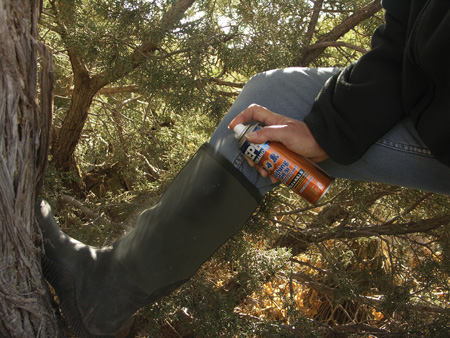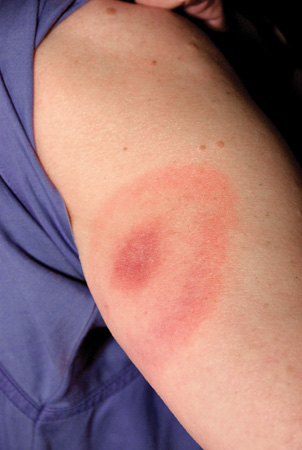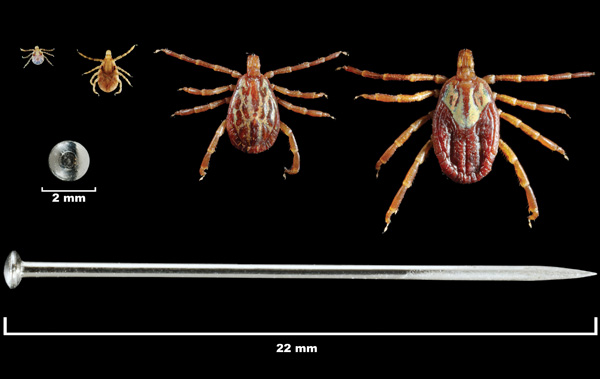Hunting when the weather is warm can pose medical concerns for hunters. Many of these concerns center on insect bites. Wherever you are, mosquitoes, black flies and ticks are out there hunting you. In many ways, these insects can initiate deadlier medical conditions than most predators can unleash.
One doesn’t have to be a hunter to encounter a minute predator responsible for Lyme disease. With its bite, an infected tick starts an infection caused by the bacterium Borrelia burgdorferi. Many times the tick is about the size of a pinhead or around 2mm in diameter. To get into his hunting territory, simply take a walk in the woods, fish from that favorite spot on the riverbank or pull weeds in your garden. All of these are outdoor activities that can put you at risk for Lyme. This is because ticks are found virtually everywhere. Because their numbers are directly related to the amount and kinds of wild animal hosts available, ticks are not uniformly dispersed in the environment. Since hosts are found where there is food, water and cover, this is where the greatest number of ticks is also found.
Not all ticks carry Lyme disease. Lyme was thought to be an obscure disease found only in certain areas of the Northeast United States only a few years ago. Today it is recognized as a deadly disorder than can affect nearly anyone who spends time outdoors, almost anywhere.
Knowledge Is Power
The key to Lyme is to understand it, and take measures to prevent it. Realizing how small the tick is, is important. This bacterial disease, associated with being in the outdoors, is caused by a spirochete (spiral shaped bacterium) known as Borrelia burgdorferi and carried by a little tick called Ixodes dammini. In 2005, the Centers for Disease Control (CDC) reported 23,305 cases nationwide. Those who spend time outdoors, especially where there is an abundance of game, are the ones most likely to be in this predator’s hunting areas.
 Lyme has been reported in 47 states with over 75 percent of all cases in the Northeast region of the United States. Although I don’t have figures for Canada, rest assured that borders mean nothing to ticks and therefore, I would assume that the Northeast regions of Canada are also home to this arthropod. It’s also interesting to note that according to Stein's Manual, Internal Medicine, Diagnosis and Therapy, this same disease has been identified in Europe and Australia. There, the tick vector (species) is different. Due to this fact, one can conclude that different tick vectors can transmit and carry Lyme and therefore, this disease is likely found throughout the world.
Lyme has been reported in 47 states with over 75 percent of all cases in the Northeast region of the United States. Although I don’t have figures for Canada, rest assured that borders mean nothing to ticks and therefore, I would assume that the Northeast regions of Canada are also home to this arthropod. It’s also interesting to note that according to Stein's Manual, Internal Medicine, Diagnosis and Therapy, this same disease has been identified in Europe and Australia. There, the tick vector (species) is different. Due to this fact, one can conclude that different tick vectors can transmit and carry Lyme and therefore, this disease is likely found throughout the world.
The threat is greatest to the hiker, camper, fisherman, gardener, archer and especially hunters who pursue game and fish from May to July. The tick is most dangerous in the early months of warm weather, again May to July. This is when they are in their nymph stage, and most likely to transmit the disease.
An Ounce Of Prevention
Far better than a pound of cure, especially when you’re dealing with a disease that’s difficult to diagnose and treat, is an ounce of prevention.
GENERAL PRECAUTIONS:
* Use a tick repellent that contains safe amounts of Deet when in a "risk area." Remember, “risk area” is virtually anywhere outdoors where animals live.
* Look at new products now on the market using Geraniol, an effective insect repellent that is Deet free.
* Wear light colored clothing to better spot the ticks (and yes, this is something the hunter can’t really do while hunting).

* Wear long sleeve shirts.
* Consider wrist and ankle bands like BugBand, treated to repel insects.
* Wear long trousers and tuck the bottoms into your socks.
* Consider using duct tape or tick “gators” to seal the opening between the top of your boot and pant legs.
* Wear a hat. You do not want them getting onto your scalp, especially if covered by hair.
* Do a body check for ticks when you get home or back to camp. Remember, the tick you are looking for is about the size of a period at the end of this sentence.
* If you find a tick, remove it with tweezers by grasping it on the mouth end and not over the central gut area since by squeezing it there, you may be pushing the infected materials into your body.
* Check your pets. They may carry ticks into your home and can also become infected. A tick can be carried on pets, birds, deer, mice, chipmunks and on you.
* After being outdoors, specifically around brush and woods, throw your clothes in the washer and take a shower.
* Wear latex gloves when field dressing and processing game. This should be done even when the odds of contracting Lyme is slim. Gloves are always recommended since body secretions and blood can transmit other infectious diseases. Be careful picking up any animal in warm weather, especially varmints and predators.
A Pound Of Cure
To protect yourself, it’s important to recognize the signs and symptoms quickly. The medical dilemma is that Lyme mimics many other diseases. Because of that, diagnosis can be difficult. If strange symptoms occur, look at the big picture, note the timing, and consider the possible cause. Even though there is not just one symptom that stands out and is specific to diagnose Lyme, here is what can be expected during the three recognized stages of this potentially debilitating illness.
First Stage: (Early Lyme)
 • A red rash (called erythema chronicum migrans) looks like the bull's eye of a target. This may appear at the sight of the bite. For some who have been diagnosed with Lyme, this was not discovered. The rash might not be painful or itchy, and some never develop the characteristic rash at all.
• A red rash (called erythema chronicum migrans) looks like the bull's eye of a target. This may appear at the sight of the bite. For some who have been diagnosed with Lyme, this was not discovered. The rash might not be painful or itchy, and some never develop the characteristic rash at all.
• There may be symptoms similar to flu. If you were hunting in warm weather and later came down with what feels like the flu, make sure it is indeed the flu and not Lyme. That means a visit to a doctor and a test.
• Another prominent sign is regional lymphadenopathy. This simply means your lymph nodes are swollen, ie. swollen glands in your armpits, neck or groin.
Second Stage: (Early disseminated Lyme)
The bacterium is spreading and affecting certain body functions. This occurs from weeks to MONTHS after the bite.
• Severe headache
• Joint and body aches and pains, and/or swelling. Pain might migrate from place to place. Don’t just blame this on getting older.
• Chills and fever
• Fatigue for no apparent reason
• Memory loss, poor concentration and possibly dizziness. Don’t immediately blame this on getting older.
• Eye and ear pain
• Heart palpitations or block, which you might notice as dizziness or fainting. This could cause stroke or death.
• Meningitis symptoms, such as a stiff neck and headache
• Many other possibilities
Third Stage: (Late or chronic Lyme)
Occurs weeks to YEARS after the tick bite.
• Arthritis. If not in your family history, you should wonder why you suddenly developed it. This is especially seen in large joints as the knees.
• Neurological problems, possibly including headache, partial paralysis, tics, tremors, poor concentration, memory loss or other nervous system disorders.
• Chronic pain in muscles
• Trouble sleeping. Aches and pain may keep you awake, or extreme fatigue can cause you to sleep excessively.
• Skin disorders, which might manifest as rash or inflammation
• Sadly, many other possibilities

Using a pin as a reference tool, this photograph depicts a dorsal view of four Amblyomma maculatum ticks. From left to right, this group of four included a larval tick, a nymph, an adult male, and at far right, an adult female. Note that the head of the pin measures just under 2mm in diameter, while its full length measures 22mm.
This tick specie is a known vector for Rickettsial organisms, Rickettsia parkeri, and Ehrlichia ruminantium, formerly Cowdria ruminantium. R. parkeri is a member of the spotted fever group of rickettsial diseases affecting humans, while E. ruminantium causes “heartwater disease”, an infectious, noncontagious, tick-borne disease of domestic and wild ruminants, including cattle, sheep, goats, antelope, and buffalo. Each life stage depicted here, can feed on human hosts, and can be infected with Rickettsia parkeri.
Diagnosis
Your physician needs to know an accurate history to help treat you. He needs to know you’ve been in tick country, and when a bite might have occurred. Unfortunately, many patients cannot pin point when that might have happened. This is also why you need to take precautions and look for trouble at the end of the day, do a body check and watch for the bull’s-eye rash. Being alert is the best preventive medicine since this is when you may locate a bite (skin is turning red) or a tick.
A blood test, called an ELISA is followed by a Western Blot test, which is a check for antibodies. This is what the body develops in response to the infection and is not a test for the specific bacteria itself. Be aware that it is possible to be positive for antibodies and you may not have Lyme since something else could have initiated a positive reaction. This is why having the Western Blot test done 6-12 weeks after infection is important. Timing is critical to diagnosis.
Testing may not yield concrete data pointing to Lyme. Here is when a good physician’s gut feeling comes into play. From the signs and symptoms, and a good history indicating when you hunted in potentially affected areas, a treatment regime may be initiated. It is a good idea to find a physician who has experience with this disease. Time is not on your side. If you suspect Lyme, seek help as soon as possible.
Treatment
Once infected, you are in for a lot of medical problems and expense, unless Lyme was properly diagnosed early and the proper medical therapy instituted immediately. Even with the best medical care, it can be quite difficult to diagnose which has been stated throughout this presentation. According to the second edition of Medical Therapeutics by Ramsey and Larson, "oral antibiotic therapy generally shortens stage one disease and prevents development of the latter stages in most patients."
Depending on the stage (again, timing and history are important), your doctor may prescribe an antibiotic such as doxycycline, tetracycline, amoxicillin, erythromycin, penicillin or ceftriaxone that MUST be taken as prescribed, which can be for 10 to 30 days and sometimes much longer. If longer, you need to be followed closely for problems that can arise from long term antibiotic use. NEVER attempt to treat yourself. Depending on the severity, intravenous antibiotics could be necessary.
This disorder, if not promptly and properly treated, is nothing to fool with. Once established, the antibiotic of choice may not work, and you could find yourself in a life threatening situation.
By being aware of this disorder, we can still enjoy the outdoors safely as long as we know what to look for and what steps to take to keep us safe. To be a “safe” hunter today, you better know your first aid and especially that section dealing with Lyme.
Featured photo: iStock





